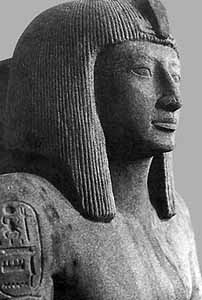

Seti II (or Sethos II), was the fifth ruler of the Nineteenth dynasty of Egypt and reigned from 1203 BC to 1197 BC. His throne name, Userkheperure Setepenre, meant "Powerful are the Manifestations of Re, Chosen by Re.' He was the son of Merneptah and wife Isisnofret and sat on the throne during a period known for dynastic intrigue and short reigns, and his rule was no different. Seti II had to deal with many serious plots, most significantly being the accession of a rival king named Amenmesse, possibly a half brother, who seized control over Thebes and Nubia in Upper Egypt during his second to fourth regnal years.
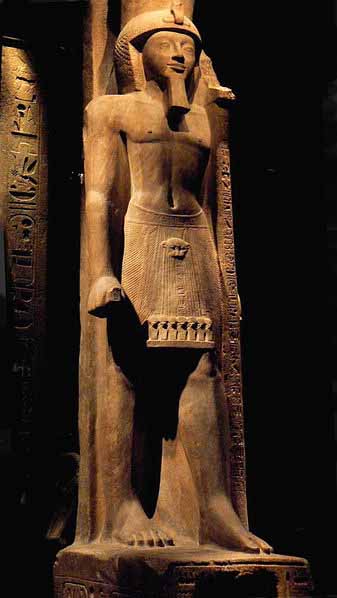
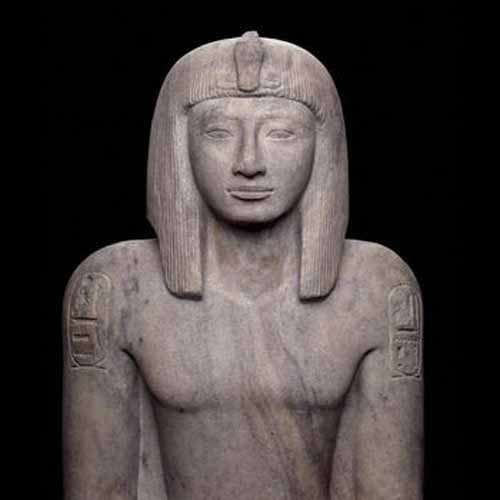
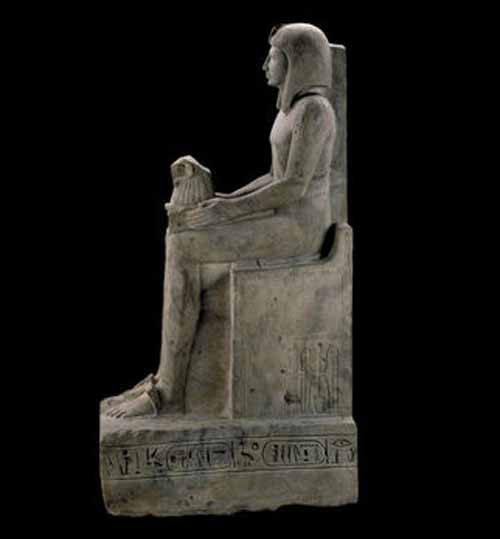
Evidence that Amenmesse was a direct contemporary with Seti II's rule - rather than Seti II's immediate predecessor - includes the fact that Seti II's royal KV13 tomb at Thebes was deliberately vandalized with many of Seti's royal names being carefully erased here during his reign. The erasures were subsequently repaired by Seti II's agents. This suggests that Seti II's reign at Thebes was interrupted by the rise of a rival: king Amenmesse in Upper Egypt.
Secondly, the German scholar Wolfgang Helck has shown that Amenmesse is only attested in Upper Egypt by several Year 3 and a single Year 4 ostracas here; Helck also noted that no Year 1 or Year 2 ostracas from Deir El Medina could legitimately be assigned to Amenmesse's reign. This conforms well with the clear evidence of Seti II's control over Thebes in his first two years which is documented by various documents and papyri. In contrast, Seti II is absent from Upper Egypt during his third and fourth years which are notably unattested here - presumably because Amenmesse controlled this region during this time.
Finally, and most importantly, it is well known that the chief foreman of Deir el-Medina, a certain Neferhotep, was killed in the reign of king Amenmesse on the orders of a certain 'Msy' who was either Amenmesse himself or one of this king's agents, according to Papyrus Salt 124.
However, the chief workman Neferhotep is attested in office in the work register list of Ostraca MMA 14.6.217 which also recorded Seti II's accession to the throne and was later reused to register worker's absence from work under this king's reign. If Seti II's 6 year reign followed that of the usurper Amenmesse, then this chief foreman would not have been mentioned in a document which dated to the start of Seti II's reign since Neferhotep was already dead. This indicates that the reigns of Amenmesse and Seti II must have partly overlapped with one another and suggests that both rulers were rivals who were fighting each another for the throne of Egypt.
During the second to fourth years of Amenmesse/Seti II's parallel reigns, Amenmesse gained the upper hand and seized control over Upper Egypt and Nubia; he ordered Seti II's tomb in the Valley of the Kings to be vandalized. Prior to his fifth year, however, Amenmesse was finally defeated by his rival, Seti II who was the legitimate successor to the throne since he was Merneptah's son. Seti II, in turn, launched a damnatio memoriae campaign against all inscriptions and monuments belonging to both Amenmesse and this king's chief supporters in Thebes and Nubia which included a certain Khaemter, a former Viceroy of Kush, who had served as Amenmesse's Vizier.
Seti II's agents completely erased both scenes and texts from KV10, the royal tomb of Amenmesse. Vizier Khaemter's scenes in Nubia which were carved when he served as the Viceroy of Kush were so thoroughly erased that until Rolf Krauss' and Labib Habachi's articles were published in the 1970s, his career here as viceroy was almost unknown notes Frank J. Yurco.
Seti II promoted Chancellor Bay to become his most important state official and built 3 tombs - KV13, KV14, and KV15 - for himself, his Senior Queen Twosret and Bay in the Valley of the Kings. This was an unprecedented act on his part for Bay, who was of Syrian descent and was not connected by marriage or blood ties to the royal family. Due to the relative brevity of his reign, Seti's tomb was unfinished at the time of his death. Twosret later rose to power herself after the death of Siptah, Seti II's successor. According to a graffito written in the first corridor of Twosret's KV14 tomb, Seti II was buried in his KV15 tomb on "Year 1, IV Peret day 11" of Siptah.
Seti II's earliest prenomen in his First Year was 'Userkheperure Setepenre' which is written above an inscription of Messuwy, a Viceroy of Nubia under Merneptah, on a rock outcropping at Bigeh Island. However, Messuwy's burial in Tomb S90 in Nubia has been discovered to contain only funerary objects naming Merneptah which suggests that 1) Messuwy may have died during Merneptah's reign and 2) Seti II merely associated himself with an official who had actively served his father as Viceroy of Kush. Seti II soon changed his royal name to 'Userkheperure Meryamun', which was the most common form of his prenomen.
Two important papyri date from the reign of Seti II. The first of these is the Tale of Two Brothers, a fabulous story of troubles within a family on the death of their father, which may have been intended in part as political satire on the situation of the two half brothers. The second is the records of the trial of Paneb. Neferhotep, one of the two chief workmen of the Deir el Medina necropolis, had been replaced by Paneb, his troublesome son-in-law.
Many crimes were alleged by Neferhotep's brother - Amennakhte - against Paneb in a violently worded indictment preserved in papyrus now in the British Museum. If Amennakhte's testimony can be trusted, Paneb had allegedly stolen stone from the tomb of Seti II while still working on its completion - for the embellishment of his own tomb - besides purloining or damaging other property belonging to that monarch.
Paneb was also accused of trying to kill Neferhotep, his adopted father-in-law, despite being educated by the latter and after the murder of Neferhotep by 'the enemy,' Paneb had reportedly bribed the Vizier Pra'emhab in order to usurp his father's office. Whatever the truth of these accusations, it is clear that Thebes was going through very troubled times. There are references elsewhere to a 'war' that had occurred during these years, but it is obscure to what this word alludes, perhaps to no more than internal disturbances and discontent.
Neferhotep had complained of Paneb's attacks on himself to the vizier Amenmose, presumably a predecessor of Pra'emhab, whereupon Amenmose had punished Paneb. This trouble-maker had then brought a complaint before 'Mose' (i.e.: 'Msy'), who then acted to remove Pra'emhab from his office. Evidently this 'Mose' must have been a person of the highest importance, perhaps the king Amenmesse himself or a senior ally of the king.
Seti II also expanded the copper mining at Timna in Edom, building an important temple to Hathor the cow goddess in the region. Abandoned in the late Bronze Age collapse, where a part of the temple seems to have been used by Midianite nomads, linked to the worship of a bronze serpent discovered in the area. Seti II also founded a station for a barge on the courtyard in front of the pylon II at Karnak, and chapels of Theban triad - Amun, Mut and Khonsu.
Seti II had three Queens in all: Twosret, possibly his half sister, Takhat and Tiaa, his third wife. Twosret is known to have survived him since she later served as Siptah's queen regent before she succeeded to the throne in her own right. Her name is recorded in Manetho's Epitome as a certain 'Thuoris' who is assigned a reign of 7 years.
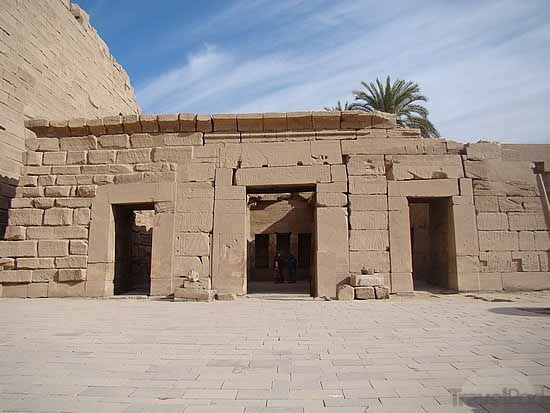
In January 1908, the Egyptologist Edward R. Ayrton, in an excavation conducted for Theodore M. Davis, discovered a small burial in tomb KV56 which Davis referred to as 'The Gold Tomb' in his publication of the discovery in the Valley of the Kings; it proved to contain a small cache of jewelry that featured the name of Seti II. Sets of "earrings, finger-rings, bracelets, a series of necklace ornaments and amulets, a pair of silver 'gloves' and a tiny silver sandal" were found within this tomb.
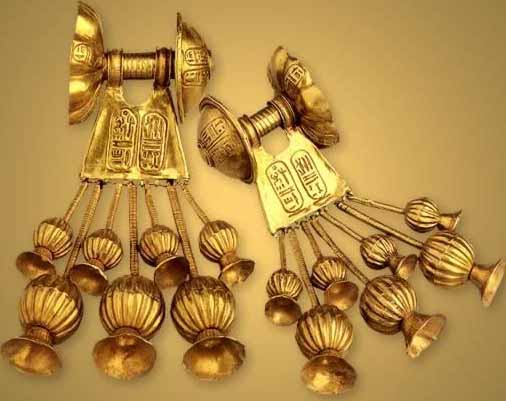
It is likely that Seti II may have originally been buried with his wife, Tausret, in her tomb and later moved to this tomb which appears to have been hastily and incompletely finished, by Sethnakht (Setakht). In fact, the tomb may have originally been started for Seti II but the work interrupted at some point. This may have had to do with the reign of Amenmeses, if that king ruled concurrently with Seti II rather than before him. It appears that within the tomb, Seti's name was carved, erased, and then carved out once again. The erasure may be attributable to Amenmeses, or possibly to Saptah. It has been suggested that his wife Twosret then had her husband's name restored.
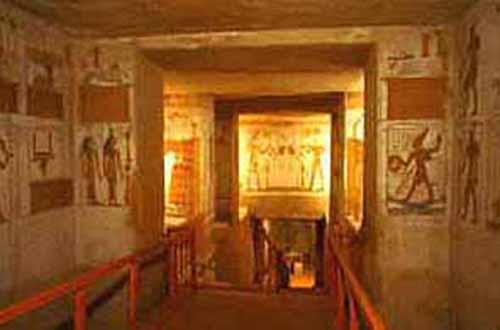
The tomb, which takes a Northwest to Southeast axis, consists of a short entryway corridor followed by three long corridors in turn followed by a well room. The well room then communicates with a four pillared hall and then a makeshift burial chamber, formed from what would have been another corridor, where the king's sarcophagus was located.
This tomb is literally a straight shot leading 75.38 meters into the cliff face with only a mild descent for the most part leading about 6.53 meters deep, and with no lateral rooms. However, a rectangular niche on the right side of the pillared hall may mark the location where the usual annex would have been cut. Missing also is the high trapezoidal niches often found at the beginning of the third corridor.
Much of the painted decoration is intact and the plaster appears to be relatively stable. None of the well-preserved relief was ever painted. Breaks in the surface of the walls have recently been filled in by Antiquities Inspectorate restorers. Due to the hurried completion of the tomb, decorations in clearly take two forms. While those in the initial part of the tomb are well formed using both sunk and raised reliefs, they give way to less accomplished work executed in paint only deeper within the tomb, with the four pillared hall being the only exception.
There, the decorations again revert to sunk reliefs, though paint was not always applied. In some of the deepest corridors, only preliminary sketches were made on the plaster surface. Throughout the tomb, even including the first corridor where we find the raised and sunk reliefs, there are stylistic differences within the craftsmanship of the work that might suggest the use of different artisans.
While the tomb may have been unfinished, unusually, the walls of the entrance were carefully smoothed and covered with a layer of white plaster, as elsewhere within the tomb. However, no decorative theme was applied to the entrance and entrance corridor walls.
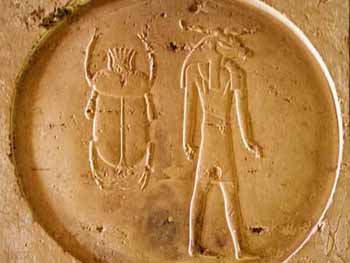
However, in the next, longer corridor (Corridor One) on the doorway lintel is depicted the kneeling goddesses Isis and Nephthys, and between them a sun disk with a scarab and a ram headed god. Inscribed on the jambs of the doorway are the names of Seti II with an image of Ma'at, also shown kneeling. Within this corridor, are depictions of Seti II making offerings to Re-Horakhty and offering vases to Nefertem followed by the initial passages of the Litany of Re on the east wall. The scene of Seti II and Nefertem were cut over the original opening vignette of the Litany of Ray which was then inscribed further down the corridor. On the west wall are scenes of Sokar and Seti II making offerings of incense and libations to Re-Horakhty.
The remainder of the corridor continues with the tests of the Litany of Re. On the ceiling of this corridor we find painted flying vultures, some with the head of a cobra and not completely painted. Between the vultures the king's name is inscribed, and along the edges of the ceiling are texts relating to Osiris and Re-Horakhty. The scenes on the next two corridors are oriented towards the rear of the tomb on the eastern walls, while on the west they run towards the tomb's entrance.
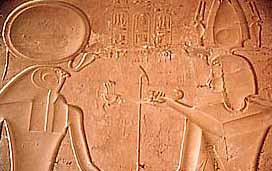
Over the outer lintel of the second corridor is found a winged disk, while on the doorjambs the Litany of Re is continued. On the walls within this corridor, the decorative theme is executed in red, preliminary sketches only. On the east wall we find Seti II making offerings to Re-Horakhty, while on the west wall he makes an offering to Sokar.
The remainder of this corridor continues with sections of the Litany of Re, including the 75 forms of the sun god. Further on, we also find the second and third hours of the Amduat on both the east and west walls. In this corridor, the ceiling once again portrays Isis and Nephthys, this time as kites, on either side of a sun disk containing the ram headed bird representing the ba (soul) of Re. This scene is followed by more text from the Litany of Re. Stars were to have filled the remainder of the ceiling, but were never completely rendered.
The outer lintel of the third corridor is decorated with a winged disk, while on the door jams we find the names and a depiction of Seti II. Within this corridor, the east wall is inscribed with representations from the fourth hour of the Amduat, while the west wall depicts the fifth hour.
Within the well room (ritual shaft) the niches at the entrance are, for the first time, fully cut. Here, an innovation is the depiction of various divine statues, many imitations of actual wooden figures similar to those found in the tomb of Tutankhamun.
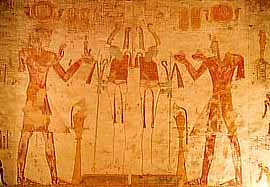
Double scene of Seti II making
Normally we would find the depiction of protective deities such as the Four Sons of Horus and the related goddesses, but for unexplained reasons these figures have been omitted.
The walls within the four pillared chamber are rendered with the fourth and fifth divisions of the Book of Gates. On the rear wall is a double scene of Seti II offering an image of Ma'at and two vases to Osiris. Here, the pillars depict Seti II, Horus -Iwn-mutef, Ptah, who is in a shrine, along with other deities. The innovative decorations on the pillars, which have only one figure on each side and two adjacent sides forming a scene, was a development used consistently from this time forward.
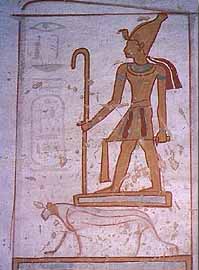
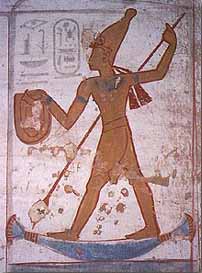
Scenes from within the Well Room
The walls within the four pillared chamber are rendered with the fourth and fifth divisions of the Book of Gates. On the rear wall is a double scene of Seti II offering an image of Ma'at and two vases to Osiris. Here, the pillars depict Seti II, Horus-Iwn-mutef, Ptah, who is in a shrine, along with other deities. The innovative decorations on the pillars, which have only one figure on each side and two adjacent sides forming a "scene, was a development used consistently from this time forward.
Finally, in the makeshift burial chamber are several registers. The upper of these contain images of Anubis the jackal on a shrine and two rows of deities representing the followers of Re and Osiris. On the lower registers are scenes of mummified figures on snake style beds representing the fifth division of the Book of Gates. Along the length of the ceiling is Nut, with down swept wings, and above her head perhaps the remains of depictions of ba of Re.
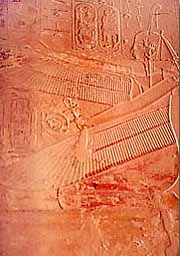
It seems they bought in the body before the tomb was finished and then went on working - a large figure of a Deity with outspread wings painted on the ceiling of above the sarcophagus - very rough. Some beautifully drawn figures of the king in red lines.
Not much in the way of funerary equipment was discovered within this tomb, and the body of Seti II had been removed during antiquity to the tomb of Amenhotep II (KV35), along with the mummies of other royalty, for safe keeping. Fragments of his red granite sarcophagus lid were present within this tomb, but no trance of the actual box was ever discovered. These fragments remain in the tomb, and have been restored and placed on supports so as to suggest the original appearance of the sarcophagus.
On the top of this sarcophagus is an Osirian depiction of Seti II, while the goddess Nut stretches across the reverse side. Unfortunately, the top of the lid is missing, along with the face of the king. However, the head of the goddess Nut is now in the Egyptian collection at the Louvre in Paris. Because this is the smallest of any New Kingdom sarcophagus ever discovered, it has been suggested by Aidan Dodson that it might in fact have been meant to nest within a larger sarcophagus, similar to that of Ramesses III.